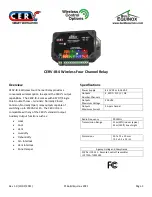
1–5
Introduction – 1
1.5
Design Considerations
There are basically two approaches in the de-
sign of digital relays. In the first approach, the
microprocessor simply replaces the relay logic
and does not process the voltage and current
signals. The performance of these relays depends
on the accuracy of the analog components used,
and is subject to dc offsets and gain drift with
temperature, supply voltage changes, or aging.
In the second approach, the microprocessor both
processes the signals and performs the logic,
providing a simpler design and offering perfor-
mance advantages. The advent of low-cost digi-
tal signal processors (DSPs), microprocessors
designed especially for the efficient numerical
procedures required, paved the way for the de-
sign of a digital relay using state-of-the-art digital
signal processing techniques, thereby eliminat-
ing the problems inherent with analog hardware.
The Beckwith Electric M-0420 Multifunction Relay
follows this second approach: analog signal-
processing hardware is replaced with a DSP.
Various parameters of the input signals are
estimated using digital signal-processing
algorithms. The voltage and current input signals
of the relay are modeled as sinusoidal signals
corrupted by dc offset and harmonic components.
These signals can be characterized by various
parameters such as rms value, peak value, rms
value/phase angle, and frequency of the
fundamental component.
However, while DSPs are highly effective for signal-
processing applications, they are not very effi-
cient for general purpose applications and have
limited memory space. Therefore, the relay uses
a dual-processor architecture. The DSP executes
all the signal-processing algorithms, while a gen-
eral-purpose (host) processor manages input/
output and other overhead functions, monitors the
keyboard for operator requests, updates memo-
ries for setpoint values, facilitates operator inter-
action via the alphanumeric display, establishes
two-way communication using the RS-232C se-
rial ports, analyzes the data from the DSP, and
issues the trip commands.
Figures 1-2 and 1-3 present a general overview
of the hardware design and functional operation
of the relay. As shown in these diagrams, the
inputs to the relay, filtered to remove higher or-
der harmonics, are multiplexed and then passed
through an Analog-to-Digital Converter (ADC) to
the DSP, which performs a discrete Fourier trans-
form (DFT) 16 times per cycle for each of the
inputs. The host processor performs all input/output
and overhead functions, including monitoring of
the status inputs, and ultimately analyzes the data
from the DSP to determine the need for a trip
command.
One significant design feature of the relay is
automatic correction of the sensing transformer
error caused by ambient temperature excursions.
Voltage transformers exhibit enough internal
resistance so that the internal regulation of the
transformer results in a significant error due to
changes in temperature. The relay includes a
temperature sensor mounted in the enclosure to
measure directly and accurately the internal
temperature of the relay. This temperature signal
is coupled through the ADC to the DSP, which
processes the information to determine the
appropriate factor required to correct the sensing
transformer error.
The relay uses an algorithm based on the DFT
to compute the frequency and to determine the
phase angle for real/reactive power measurements.
The algorithm uses voltage phasor estimates ob-
tained from the DFT to compute reliable estimates
of frequency unaffected by dc and harmonic com-
ponents in the signal. Additionally, deriving the
positive sequence voltage phasor from the DFT
means that the frequency function will continue
to operate should any single- or two-phase fault
occur.
Содержание M-0420
Страница 56: ...M 0420 Instruction Book 3 4 This Page Intentionally Left Blank ...
Страница 92: ...M 0420 Instruction Book 5 28 This Page Left Intentionally Blank ...
Страница 156: ...A 8 M 0420 Instruction Book This Page Intentionally Left Blank ...
Страница 160: ...B 4 M 0420 Instruction Book This Page Intentionally Left Blank ...
Страница 164: ...C 4 M 0420 Instruction Book This Page Intentionally Left Blank ...
Страница 165: ...D 1 Board Interconnections Appendix D D Board Interconnections Figure D 1 M 0420 Board Interconnections ...
Страница 166: ...D 2 M 0420 Instruction Book This Page Intentionally Left Blank ...
Страница 174: ...E 8 M 0420 Instruction Book This Page Intentionally Left Blank ...











































